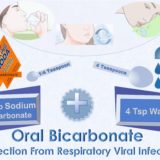Telehealth Reverse Diabetes And Prevent Cancer | Free Trial In Texas

Diabetes with Obesity and No Exercise is as much of a risk for Cancer as Smoking Cigarettes.
In the last 50 years, smoking has decreased by two thirds while obesity has increased by three quarters. Diabetes has doubled.
We’ve done something about smoking causing cancer. When are we going to do something about toxic excess calories that cause cancer?
Visit our website: www.herdhealthcare.com, or call us at 713-669-0271 to get started on an action plan for good health.
History Of Diabetes And Cancer
We’ve known about the association between diabetes and cancer for more than 100 years. Longer than we’ve known about insulin. We’ve had statistical proof of the association for about 10 years.
We now know there’s a strong association between diabetes and cancer of the liver, pancreas and uterus. About 2-fold increase in risk. There’s a lesser risk for cancer of colon, breast and bladder. About 1.2-fold to 1.5-fold lifetime risk.
Diabetes, Overweight/Obesity And Combined Risk
Both Diabetes and Overweight/Obesity carry greater than average risk for disability and death. Both carry greater risk for cancer. The question is whether Overweight/Obesity simply carries risk for both Cancer and Diabetes. Or does Diabetes have a separate risk for Cancer?
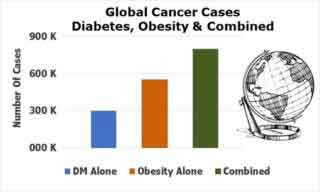 The Figure shows that individually, Overweight/Obesity caused almost twice as many cases as Diabetes. However, there were a few cases caused by Diabetes separate from the effects of Overweight/Obesity.
The Figure shows that individually, Overweight/Obesity caused almost twice as many cases as Diabetes. However, there were a few cases caused by Diabetes separate from the effects of Overweight/Obesity.
The risk for Cancer is increased about 25% for individuals who are Overweight and 25% for individuals with Diabetes. Those with Obesity have risks for Cancer that are 50% to 80% greater than individuals of normal healthy weight.
The overwhelming suspicion is that there is something common to both conditions that causes cancer. That something appears to be high levels of insulin in both conditions. Individuals with Obesity consume greater amounts of toxic calories in excess with higher levels of insulin circulating after meals and overnight.
Diabetes And Cancer
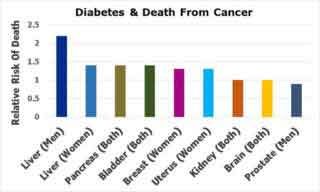 Cancer of the liver is the most common cause of death from Cancer in individuals with Diabetes. As can be seen in the Figure, men with Diabetes and Cancer of the liver have the greatest risk. They have more than twice the risk of death from Cancer than men who do not have Diabetes.
Cancer of the liver is the most common cause of death from Cancer in individuals with Diabetes. As can be seen in the Figure, men with Diabetes and Cancer of the liver have the greatest risk. They have more than twice the risk of death from Cancer than men who do not have Diabetes.
Women with Diabetes have 30% increased risk of death from Cancer of the breast or uterus compared to women who do not have Diabetes.
Men with Diabetes actually have a 10% lower risk of death from Cancer of the prostate. This may be caused by decreased levels of testosterone commonly found in men who have Diabetes.
The risk for men with Diabetes in developing Cancer of the colon is increased by 80%. Fortunately, screening and early treatment prevent increased risk of death. The Figure shows that women have a 36% increase in risk for developing Cancer of the colon. However, Cancer of the colon is readily detected and treated early in the course of disease.
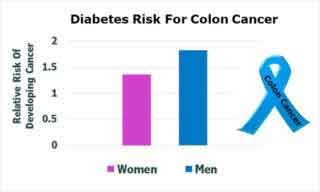 Apparently, men and women with Diabetes are screened for Cancer of the colon more than those with Obesity without Diabetes. As a result, deaths from Cancer of the colon are much less common in those with Diabetes than reported for men and women with Obesity.
Apparently, men and women with Diabetes are screened for Cancer of the colon more than those with Obesity without Diabetes. As a result, deaths from Cancer of the colon are much less common in those with Diabetes than reported for men and women with Obesity.
Obesity And Death From Cancer
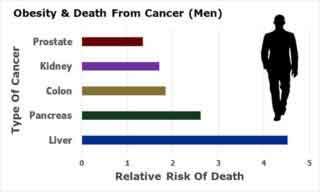 A study of more than 900,000 men and women in the U.S. showed the relation between Obesity and deaths from Cancer. During 16 years of follow-up, Obese men had 52% greater rates and Obese women had 62% greater rates of death from Cancer than adults of normal healthy weight.
A study of more than 900,000 men and women in the U.S. showed the relation between Obesity and deaths from Cancer. During 16 years of follow-up, Obese men had 52% greater rates and Obese women had 62% greater rates of death from Cancer than adults of normal healthy weight.
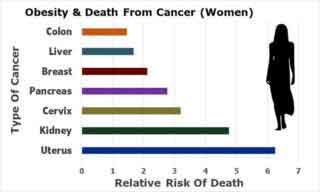 The Figures show that men had 4.5-fold increase in death from Cancer of the liver and 2.6-fold increase in death from Cancer of the pancreas. Death from Cancer of the prostate were 34% higher than men of normal healthy weight. Women had more than 6-fold increase in death from Cancer of the uterus and 2-fold difference in Cancer of the Breast. Trends in rates of death from Cancer showed higher rates of death for adults with higher measures of Obesity.
The Figures show that men had 4.5-fold increase in death from Cancer of the liver and 2.6-fold increase in death from Cancer of the pancreas. Death from Cancer of the prostate were 34% higher than men of normal healthy weight. Women had more than 6-fold increase in death from Cancer of the uterus and 2-fold difference in Cancer of the Breast. Trends in rates of death from Cancer showed higher rates of death for adults with higher measures of Obesity.
Estimates from these data showed 14% of deaths from Cancer in men and 20% of deaths in women were caused by Overweight/Obesity.
Physical Activity And Risk Of Cancer
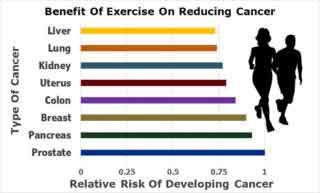 The benefit of exercise decreasing risk of Cancer has been shown in more than 1 million men and women in U.S. and Europe. These data included all forms of exercise from low to high intensity.
The benefit of exercise decreasing risk of Cancer has been shown in more than 1 million men and women in U.S. and Europe. These data included all forms of exercise from low to high intensity.
The Figure shows the benefit of exercise for types of Cancer most frequently reported. In all the groups studied, higher levels of activity were associated with lower risks for 13 of 26 types of Cancer including liver, lung, kidney and uterus. For all types of Cancer, higher levels of activity were associated with 7% lower risk of Cancer.
There were no systematic differences between benefits of exercise in relation to body weight. Overweight/Obese individuals had the same benefits from exercise as adults with normal healthy weight. Although Obese individuals had greater risk of Cancer than adults of normal weight, they still effectively reduced risk of Cancer by physical activity.
Causes Of Cancer With Diabetes
The most obvious features of Diabetes which might cause Cancer are the high levels of sugar (hyperglycemia), fat (free fatty acids) and insulin (hyperinsulinemia) in the circulation. Also, there are mitogens, growth factors, inflammatory agents and hormones that might contribute. Even the drugs used to treat diabetes must be considered as possibly causing Cancer.
Insulin is a hormone with several actions. It affects metabolism, cell growth and formation of new blood vessels.
Its effects on metabolism facilitate the entry of sugar and fat into cells, its effect on the liver stores glucose and its effects on fat cells inhibit release of glucose. All these actions reduce levels of sugar in the blood stream.
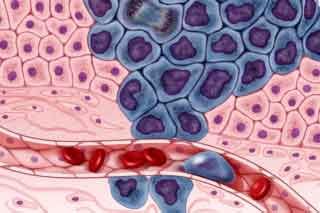 Its effects on cell growth cause proliferation and specialization. Its effect on fat tissue stimulates the formation of new cells that can absorb sugar and store fat.
Its effects on cell growth cause proliferation and specialization. Its effect on fat tissue stimulates the formation of new cells that can absorb sugar and store fat.
Its effects on blood vessels enables circulation of blood to new cells. It enhances delivery of fresh blood to newly formed cells.
The proven effects of insulin in tissue culture show its ability to stimulate the growth of malignant cells. It also creates new blood vessels to supply the malignant cells with nourishment for further growth.
Hyperglycemia (sugar) supplies energy for growth of malignant cells. It also strengthens the effect of growth factors and enhances invasive activities of malignant cells.
Fatty acids regulate the formation and degradation of complex molecules involved in cell growth, division and eventual death. When tumor cells grow they use proteins and fatty acids to enhance growth and delay cell death. They also function as a source of fuel providing energy for cell function. Through all these actions, high levels of fatty acids in blood facilitate tumor growth and invasion of surrounding tissue.
Medications used to treat diabetes lower circulating levels of sugar and fat in the blood. Most of those medications act to increase secretion of insulin or enhance its action. Consequently, lowering high levels of sugar and fat in the blood frequently increases levels of insulin circulating in the blood.
Practical Applications Treating Diabetes And Preventing Cancer
High levels of sugar and fat in the blood must be controlled. Otherwise, those high levels cause acidosis and dehydration. Untreated, ketoacidosis will cause coma and even death.
 Fortunately, insulin enhances clearance of sugar and fat into fat tissues. That prevents production of dangerously high levels. Insulin is essential to prevent ketoacidosis, dehydration, coma and death.
Fortunately, insulin enhances clearance of sugar and fat into fat tissues. That prevents production of dangerously high levels. Insulin is essential to prevent ketoacidosis, dehydration, coma and death.
So here we are. Insulin increases risk of cancer. Treatment that increases levels of insulin to control sugar and fat in the blood increases risk for cancer.
Insufficient insulin causes ketoacidosis, dehydration, coma and death. Which would you rather have?
The correct answer is to Reverse Diabetes and Prevent Cancer. Manage nutrition and physical activity to prevent excess calorie toxicity.
• Control levels of sugar and fat in blood to Reverse Diabetes
• Decrease levels insulin in blood between meals and overnight
• Prevent Cancer
We are pleased to share our blog articles with you, and we are always interested to hear from our readers. Our website address is: www.herdhealthcare.com





